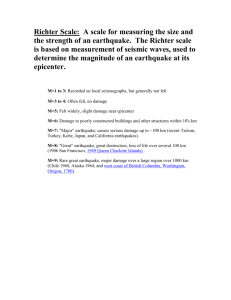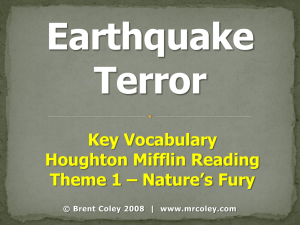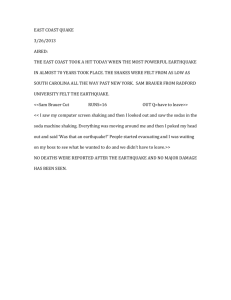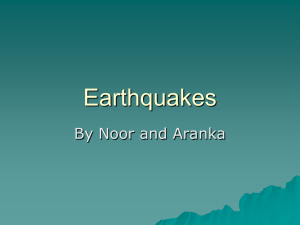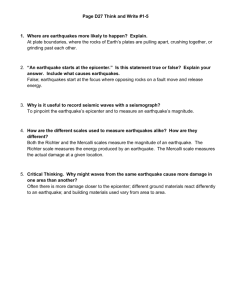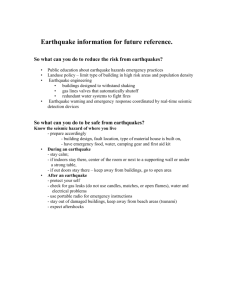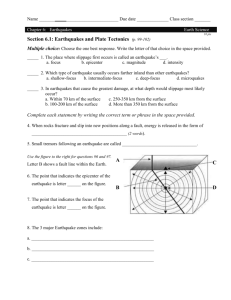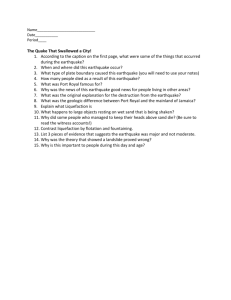GEOLOGY 220: TECTONICS
advertisement
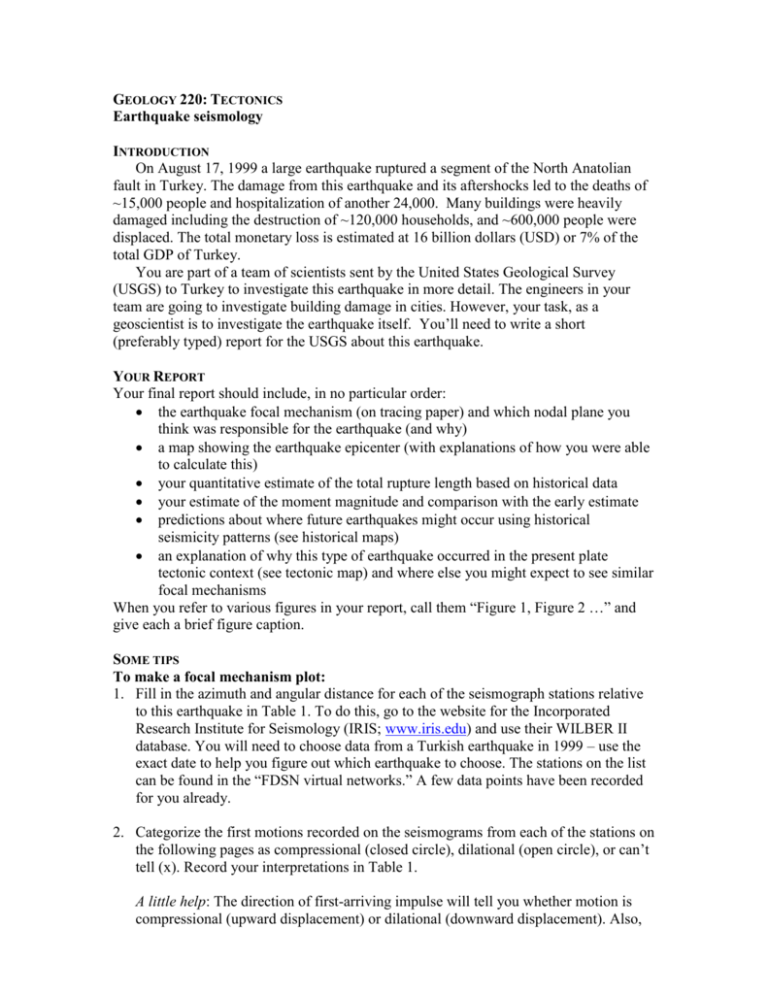
GEOLOGY 220: TECTONICS Earthquake seismology INTRODUCTION On August 17, 1999 a large earthquake ruptured a segment of the North Anatolian fault in Turkey. The damage from this earthquake and its aftershocks led to the deaths of ~15,000 people and hospitalization of another 24,000. Many buildings were heavily damaged including the destruction of ~120,000 households, and ~600,000 people were displaced. The total monetary loss is estimated at 16 billion dollars (USD) or 7% of the total GDP of Turkey. You are part of a team of scientists sent by the United States Geological Survey (USGS) to Turkey to investigate this earthquake in more detail. The engineers in your team are going to investigate building damage in cities. However, your task, as a geoscientist is to investigate the earthquake itself. You’ll need to write a short (preferably typed) report for the USGS about this earthquake. YOUR REPORT Your final report should include, in no particular order: the earthquake focal mechanism (on tracing paper) and which nodal plane you think was responsible for the earthquake (and why) a map showing the earthquake epicenter (with explanations of how you were able to calculate this) your quantitative estimate of the total rupture length based on historical data your estimate of the moment magnitude and comparison with the early estimate predictions about where future earthquakes might occur using historical seismicity patterns (see historical maps) an explanation of why this type of earthquake occurred in the present plate tectonic context (see tectonic map) and where else you might expect to see similar focal mechanisms When you refer to various figures in your report, call them “Figure 1, Figure 2 …” and give each a brief figure caption. SOME TIPS To make a focal mechanism plot: 1. Fill in the azimuth and angular distance for each of the seismograph stations relative to this earthquake in Table 1. To do this, go to the website for the Incorporated Research Institute for Seismology (IRIS; www.iris.edu) and use their WILBER II database. You will need to choose data from a Turkish earthquake in 1999 – use the exact date to help you figure out which earthquake to choose. The stations on the list can be found in the “FDSN virtual networks.” A few data points have been recorded for you already. 2. Categorize the first motions recorded on the seismograms from each of the stations on the following pages as compressional (closed circle), dilational (open circle), or can’t tell (x). Record your interpretations in Table 1. A little help: The direction of first-arriving impulse will tell you whether motion is compressional (upward displacement) or dilational (downward displacement). Also, all the first arrivals are conveniently aligned for you along a vertical line. Waviness left of this vertical line is noise (for our purposes) and should be ignored. 3. Determine the focal mechanism for this earthquake. a. For each station, you will plot a point on an equal area stereonet (closed circle = compressional; open circle = dilational, x = can’t tell). To locate each station on the stereonet, use the azimuth from Table 1. The angular distance is the number of degrees from the center of the stereonet along a line towards the azimuth. This is not the same as a “plunge.” b. Once you have plotted all the stations, determine the nodal planes for this firstmotion diagram. To do this, you will need to find planes that separate general regions of compression and dilation. Since we are working with real data, the data may not work out perfectly, but do your best. Remember that the two nodal planes must be perpendicular to one another. c. Record the strike and dip of the two nodal planes on the bottom of your stereonet. d. Last, color the compressional quadrants lightly in colored pencil. Leave the dilational quadrants blank. For finding the earthquake epicenter: Determine the earthquake epicenter and plot it on the map of Europe. Use the latitude and longitude of the following three stations: AQU-MN: OBN: KEV-IU: 42.35˚N; 13.41˚E 55.11˚N; 36.57˚E 69.76˚N; 27.01˚E You will need to convert the angular epicentral distance from Table 1 into the equivalent number of km on the curved surface of the Earth. Use trigonometry and be sure to explain at least one of your calculations in the final report (perhaps with a cartoon picture to help illustrate what you did). To compute rupture length: Before you even went into the field, you were already making hypotheses about this earthquake. Estimate the rupture length of the earthquake based on early estimates of its magnitude (M 7.6) and the historical earthquake data, especially the map with rupture lengths and magnitudes of previous earthquakes from the 20th century (gray map). Your estimate should be quantitative and you should explain the method that you used for this estimate. Compare this with the length of the fault affected by aftershocks. To compute earthquake magnitude: Verify (or refute) the early estimates of earthquake magnitude by computing the moment magnitude yourself. Use your estimate of the total rupture length. Check this estimate by computing the moment magnitude yourself. Several useful figures have been included for this calculation. Last, some typical values of the shear modulus of rocks are ~15-30 GPa. In order to find the moment magnitude, the units for seismic moment should be in dyne-cm. Table 1: Seismometer station list Station name ALE.II AQU.MN ARU.II BRO.II BGCA.GT BRVK.II BTDF.MS COCO.II DRLN.CN ECH.G ESK.II FRB.CN FURI.IU GRFO.IU IDI.MN KEV.IU KIEV.IU KIV.II KMBO.IU KMI.IC KONO.IU LSA.IC MAJO.IU MAKZ.IU MSEY.II NIL.II NRIL.II OBN.II PAB.IU RCBR.IU SFJ.IU SHEL.II SSB.G SUR.II TAM.G TSUM.IU WRAB.II WUS.G YAK.IU YSS.IU Ang. distance Azimuth 50.15 350 17.08 303 76.95 99 26.17 315 15.85 310 10.02 67 22.77 332 37.53 62 15.05 14 65.39 218 60.73 193 74.26 40 First motion Comments Figure 1. Map of Europe. Plot earthquake epicenter on this map. Figure 2: Displacements measured along the North Anatolian fault follwing the August 17th event. Modified from something that I found online and can no longer find. Figure 3: Tectonic map of the Mediterranean. Modified from USGS circular. Figure 4. From Ozaleybey et al (2002). Upper panel: Epicenter location distribution for the August 17 earthquake and aftershocks until 20 October 1999 plotted on a digital elevation map. The main strands of the North Anatolian fault zone are shown in gray lines. Lower panel: Depth of earthquakes along cross-section parallel to the strike of the North Anatolian fault zone from west to east. Figure 5. On next page. Maps of historical seismicity along the North Anatolian fault. Modified from Stein et al. (1997) and the USGS (http://earthquake.usgs.gov/research/geology/turkey/images/turkey_loc.html). Figure 6. Seismograms from selected stations. From Steve Boss, Univ. of Arkansas.
